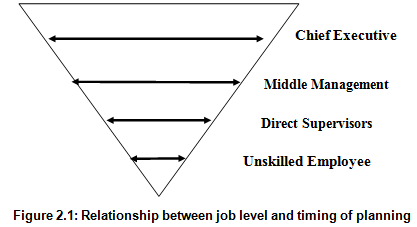The learning objectives of this chapter
After reading and completely understanding this unit, you will be able to know:
· The key factors which should be considered in determining how far into the future an organization should try to plan.
· Why the length of plans within organizations should vary depending on the job level of the person planning.
· The role of planning tools such as GANTT and PERT charts in aiding short-term planning.
How far ahead should we plan?
There is no fixed rule which says precisely how far into the future an organization should plan. There are, however, a number of factors that should be considered carefully during the process of deciding the time span to be covered. Among the most important are:
(1) The expected degree of organizational permanency
(2) The size and complexity of the organization
(3) The nature of the products or services offered
(4) The resources needed to implement the plan
The relationship between the job level and the timing of planning
The particular job level or responsibility of any individual within an organization has an important impact on the time period for which that person should plan.
We can illustrate the relationship between the job level (the hierarchy of the organizational structure) and the time spent in planning in Figure 2.1.

According to Figure 2.1, individuals at the top of an organization have to take a longer view than any other person. Conversely, those with the entry level responsibilities plan on very short horizons.
The chief executive of an organization is responsible for the survival and overall direction of the organization. The person in that role should be thinking about what could and should be done in the months, years, and possibly generations ahead.
The middle manager, who is often charged with the responsibility of one area or function within the organization, must interrelate planning with other units of the organization and with the organizational structure in which he or she reports.
The direct line supervisor or manager may have significant impact on the future of an organization but typically has little personal involvement with the decisions reached about the future.
The individual whose job requires specific skills will confine most of his job planning to hours, days, and at most weeks.
Methods / Techniques for Short-Term Job Planning
Among the most common are:
(a) Gantt charts.
(b) PERT system/charts